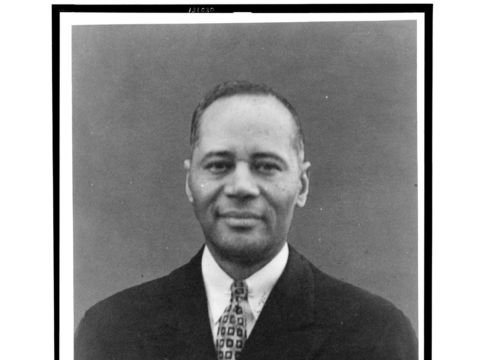Four black NBA superstars opened this year’s ESPY awards with a powerful speech decrying the current state of race relations in America, which they described as plagued by “injustice, distrust, and anger.” In a stark display of frustration and passion, Carmelo Anthony, Chris Paul, Dwayne Wade, and LeBron James highlighted the urgency for unity and change, stating, “We all have to do better.”
 By using their celebrity status to promote social change, these star athletes stood as influential role models for millions of Americans, including the children who idolize them. But students of color shouldn’t need to rely on star athletes to find positive role models to emulate. In schools across the country, teachers of color serve that role every day, inspiring students to work hard and aim high. Although these slogans might seem a little saccharine, the hopes and expectations that teachers hold for their students matter. Those authentic sentiments of a reassuring mentor are the armor a young person uses to fight off moments of self-doubt and perceived inadequacy as they venture out into the world.
By using their celebrity status to promote social change, these star athletes stood as influential role models for millions of Americans, including the children who idolize them. But students of color shouldn’t need to rely on star athletes to find positive role models to emulate. In schools across the country, teachers of color serve that role every day, inspiring students to work hard and aim high. Although these slogans might seem a little saccharine, the hopes and expectations that teachers hold for their students matter. Those authentic sentiments of a reassuring mentor are the armor a young person uses to fight off moments of self-doubt and perceived inadequacy as they venture out into the world.
Three Theories
At least three distinct theories have been proposed about how moving away from a majority-white teacher workforce would be beneficial for students of color (a detailed accounting of the relevant references can be found in this recent policy brief).
The first is the role-modeling hypothesis just described—minority students might benefit from seeing adults with a similar racial/ethnic background in a position of authority. Such representation could increase the cultural value students place on academic success and perhaps reduce the stigma of “acting white.”
The second theory relates to teachers’ expectations for their students. If teachers of color hold higher expectations for minority students—stemming from their perceptions about student ability, effort, and behavior—they might be more likely to push students to work hard and to insist on their best effort in all assignments.
The third theory relates to teachers’ cultural understanding of their students, which can lead to a deep and meaningful interpersonal connection. Racially diverse teachers might be more culturally sensitive and less likely to subscribe to biased stereotypes about their students. Diverse teachers might also influence instructional context, such as through the development of culturally relevant curricula and pedagogy and by introducing a topic from a perspective that students can relate to.
New Research Evidence
Because of data availability, empirical research to date on this subject has largely focused on the first two theories, looking for changes in academic outcomes for evidence to support the “role modeling” or the “high expectations” hypotheses.[1] In a new working paper, we too find evidence supporting both of these theories, but are particularly excited about the evidence we uncover to support the third theory.
Let’s briefly talk about the first two theories. Related to the first theory of “high expectations,” we find students assigned to a teacher who shares their race and gender are more likely to say their teacher pushes them to work hard, requires them to explain their answers, not to give up when the work gets hard, and accepts nothing less than their full effort. These effects are most pronounced among black students linked with black teachers. Related to the second theory of “role modeling,” we find that black females assigned to black female teachers say they think more about going to college because of their teacher.
What we find especially compelling, however, is the evidence we uncover in support of the third theory, based on cultural understanding. This theory posits that teachers from a similar background as their students are uniquely positioned to explain new material in a culturally relevant way. Our findings support this concept. Specifically, students assigned to demographically similar teachers say their teachers notice if they don’t understand a topic and explain it another way. Also, difficult material is explained clearly and teachers take the time to provide feedback on students’ written work so they can understand how to do better in the future.
Further bolstering support for this third theory, the largest effect sizes we uncover demonstrate perceived differences in instructional techniques that are associated with teacher/student demographic similarity. Students are more likely to report that their teacher confers with them regularly, checking to see if they understand new material and inviting them to share their insights and ideas.
The “cultural understanding” theory also supports the idea that students of color assigned to diverse teachers might be more likely to feel cared for and happy in class as a result of feeling understood by a culturally sensitive teacher. Interestingly, the students in our data reveal a strong interpersonal connection with their teacher. Students are more likely to report feeling cared for, being captivated by their teachers’ instruction, and feeling generally happy in class when assigned to a teacher that looks like them. Finally, we find significant differences in black males’ perceptions of their teacher’s ability to control the classroom. They describe orderly and productive classrooms that are conducive to learning, with little time being wasted on disciplining students whose behavior is out of control. Again, these findings are in line with a theory of improved cultural understanding.
It’s important to acknowledge, of course, that possessing similar demographic characteristics doesn’t always translate to a shared cultural heritage. Nonetheless, large-scale diversification of the teacher workforce would greatly increase the potential for a common cultural understanding between minority students and their teachers to occur, relative to the odds of such an occurrence today.
The results of this new research demonstrate that the potential benefits of increased teacher diversity extend well beyond standardized test scores, raising important questions about lost opportunities caused by the underrepresentation of minority teachers in America today.
[1] Longitudinal student-level datasets have allowed researchers to uncover small but statistically significant benefits for students’ math and reading outcomes. More recent research has examined non-test score outcomes, uncovering differences by race/ethnicity in teacher expectations for students’ educational attainment and subjective evaluations of students’ academic ability.
— Anna J. Egalite and Brian Kisida
Anna Egalite (@annaegalite) is an Assistant Professor in the Department of Educational Leadership, Policy, and Human Development at North Carolina State University.
Brian Kisida (@briankisida) is an Assistant Research Professor in the Department of Economics and the Truman School of Public Affairs at the University of Missouri.
This first appeared on the Brown Center Chalkboard.





